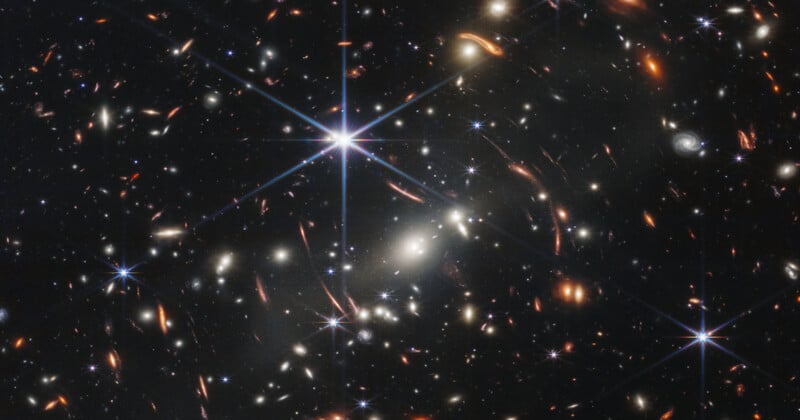Einstein’s Theories Questioned in Evaluation of Time Distortions in Space

Researchers from the Université de Genève (UNIGE) in Switzerland have developed a novel method for testing Euler’s and Einstein’s famous theories for the accelerating expansion of the universe and the nature of dark matter.
Cosmological investigations, including those using space telescopes such as Webb to peer into the ancient universe, put longstanding theories about the nature of the universe to test, including those outlined by Leonard Euler in the 18th century and Albert Einstein in the 20th century.
“The cosmos is a unique laboratory for testing the laws of physics, in particular those of Euler and Einstein. Euler described the movements of celestial objects, while Einstein described the way in which celestial objects distort the universe,” explains a statement released by UNIGE.
“Since the discovery of dark matter and the acceleration of the Universe’s expansion, the validity of their equations has been put to the test: are they capable of explaining these mysterious phenomena? A team from the University of Geneva (UNIGE) has developed the first method to find out. It considers a never-before-used measure: time distortion. The results are published in Nature Astronomy.”
Euler, whose influence remains felt today through many equations, formulas, functions, and theories, provided scientists with the tools required to calculate the movements of galaxies. Likewise, Einstein’s work underpins modern understanding of the universe, including his famous theory of general relativity, which shows that the universe is not static and demonstrates how star clusters and galaxies distort the visible universe.
Euler and Einstein’s work has been repeatedly tested by physicists, and thus far, no findings have significantly disrupted or outright disproved Euler or Einstein. However, “the Break All the Things” stage is vital in science, and the universe is a bogglingly giant laboratory, so physicists continue to evaluate the work of Euler and Einstein.
There remain open questions, especially concerning the universe’s expansion and when considering dark matter.
“By peering at galaxies located billions of light-years from Earth, researchers hope to spot signs of an effect called gravitational redshift, wherein light becomes redder after escaping the gravitational pull of massive objects. This redshifted light contains clues about how the gravitational fields of massive objects warp time, which could constrain a host of unanswered questions about our universe,” writes Becky Ferreira for Vice.
“Physicists have tested these equations in all sorts of ways, which have so far proved successful. However, two discoveries continue to put these models to the test: the acceleration of the Universe’s expansion and the existence of invisible dark matter, which is thought to account for 85% of all matter in the cosmos. Do these mysterious phenomena still obey the equations of Einstein and Euler? Researchers are still unable to answer this question,” writes UNIGE.
“The problem is that current cosmological data do not allow us to differentiate between a theory that breaks Einstein’s equations and one that breaks Euler’s equation. This is what we demonstrate in our study. We also present a mathematical method for solving this problem. This is the culmination of ten years of research,” says Camille Bonvin, associate professor in the Department of Theoretical Physics in the UNIGE Faculty of Science and first author of the study.
While Euler’s and Einstein’s equations can seemingly coexist in a wide range of situations, at the very edge of the universe, a “missing ingredient” has been troublesome. The missing ingredient is the measurement of time distortion.
“Until then, we only knew how to measure the speed of celestial objects and the sum of the distortion of time and space. We have developed a method for accessing this additional measurement, and it’s a first,” explains Bonvin.
Einstein’s theory of general relativity requires that time distortion equal the sum of time and space. If this is not the case, then Einstein’s model, which has thus far passed every test, no longer applies to the entire universe.
Poking and prodding Einstein’s theory to see if it stands up is not new. Einstein’s work has been under scrutiny since the theory of general relativity withstood its first significant test in 1919. Physicists have also worked to create rival explanations for the workings of the universe in case it turns out that Einstein’s theory fails.
The current understanding of dark matter and dark energy relies upon assumptions resulting from the theory of general relativity, so if new research and measurements cast doubt on Einstein’s theory, then all cosmological hell breaks loose.
“This will allow us to discover whether new forces or matter, which violate these two theories, exist in the Universe,” explains Levon Pogosian, study co-author and professor in the Department of Physics at Simon Fraser University in Canada.
The measurement method put forth by Bonvin and Pogosian will be tested shortly. The study’s results contribute to several ongoing missions, including launching the European Space Agency’s EUCLID space telescope next month and the Dark Energy Spectroscopic Instrument (DESI) project currently performing observations. The method will also be integrated into the Square Kilometer Array (SKA) giant radio telescope that will begin observing deep space from South Africa and Australia in 2028 or 2029.
“Our method will be integrated into these different missions. This is already the case for DESI, whom we have become external collaborators thanks to this research,” says Bonvin.
“The research team has successfully tested its model on synthetic catalogs of galaxies. The next stage will involve testing it using the first data supplied by DESI, as well as identifying the obstacles and minimizing the systematic features that could hamper its application,” explains UNIGE.